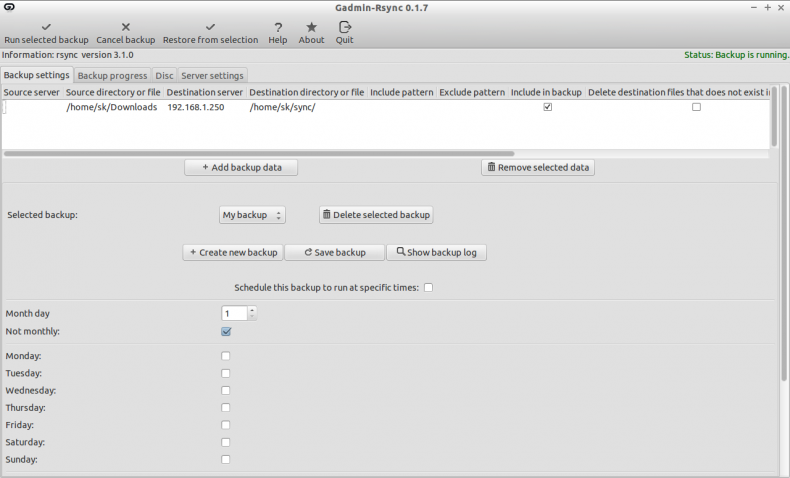
- GRSYNC EXPORT AS RSYNC SCRIPT HOW TO
- GRSYNC EXPORT AS RSYNC SCRIPT INSTALL
- GRSYNC EXPORT AS RSYNC SCRIPT UPGRADE
- GRSYNC EXPORT AS RSYNC SCRIPT VERIFICATION
- GRSYNC EXPORT AS RSYNC SCRIPT TRIAL
There’s now a directory called dir1 with 100 empty files in it. The syntax for rsync operates similar to other tools, such as ssh, scp, and cp.įirst, change into your home directory by running the following command: Due to its ubiquity on Linux and Unix-like systems and its popularity as a tool for system scripts, it’s included on most Linux distributions by default. Rsync is a very flexible network-enabled syncing tool. This guide was validated on machines running Ubuntu 20.04, although it should generally work with any computers running a Linux-based operating system that have rsync installed. Then, copy each server’s public key to the other server’s authorized_keys file as outlined in Step 2 of that guide. Regardless of what types of machines you use to follow this tutorial, you will need to have created SSH keys on both of them. To set up these servers, follow our Initial Server Setup Guide. If you plan to follow this guide using servers, it would be prudent to set them up with administrative users and to configure a firewall on each of them. These two machines could be virtual private servers, virtual machines, containers, or personal computers as long as they’ve been properly configured. In order to practice using rsync to sync files between a local and remote system, you will need two machines to act as your local computer and your remote machine, respectively.
GRSYNC EXPORT AS RSYNC SCRIPT HOW TO
In this tutorial, we’ll define Rsync, review the syntax when using rsync, explain how to use Rsync to sync with a remote system, and other options available to you. It uses an algorithm to minimize the amount of data copied by only moving the portions of files that have changed. This GitHub "recipe" contains a couple of scripts and a procedure that may be useful for those who wish to verify that rsync has faithfully replicated all extended attributes and ACLs.Rsync, which stands for remote sync, is a remote and local file synchronization tool. Using ivv with -dry-run will reliably inform you of what's going to happen before it happens. The -ivv options are useful for debugging, providing a detailed accounting of the changes. rsync provides options that support that: % rsync -rlAXtgoDivv -dry-run -fake-super /source/ /destination It's a very good idea to make a dry run, and review rsync's proposed changes before committing. Rsync can create a mess if options are applied will-nilly.
GRSYNC EXPORT AS RSYNC SCRIPT TRIAL
# -dry-run perform a trial run with no changes made # -fake-super store/recover privileged attrs using xattrs (for ACLs & XATTRs) # -xattrs, -X preserve extended attributes # -acls, -A preserve ACLs (implies -perms, -p) Here's a summary of some useful options: # -r recursive recurse into directories In the current version of rsync (ver 3.2.4), the following options have demonstrated their ability to accurately preserve extended attributes and ACLs across the backup-restore cycle: % rsync -rlAXtgoD -fake-super /source/ /destination Apple will not abide GPLv3 even when it has substantial benefit for their customers.

With this version of rsync, the right options to use will be: rsync -avAX /source /destinationĪnd if you read me thus far, you are pretty good enough now to read man rsyncĪs suggested in his answer, using the ancient 2.6.9 version of rsync is an exercise in frustration and confusion.
GRSYNC EXPORT AS RSYNC SCRIPT UPGRADE
Upgrade your PATH so as to find the port command in itįor example, I installed it in /local/bin and modified my PATH
GRSYNC EXPORT AS RSYNC SCRIPT INSTALL
GRSYNC EXPORT AS RSYNC SCRIPT VERIFICATION
These problems will be shown thanks to the -v option.Ī verification of the output of rsync is mandatory.


Warning: the standard version of rsync on OS X, version 2.6.9 (see rsync -version) still The -E option means copy extended attributes and ACL, and is mandatory on HFS+ filesystems.

Next runs: rsync -avE /source /destination The best way is to continue to use rsync so as to maintain /destination synchronized with /source.


 0 kommentar(er)
0 kommentar(er)
